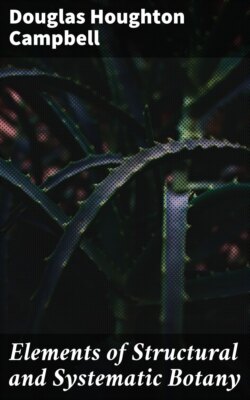Читать книгу Elements of Structural and Systematic Botany - Douglas Houghton Campbell - Страница 19
На сайте Литреса книга снята с продажи.
ОглавлениеFig. 20.—Forms of Desmids. A, B, Closterium. C, D, Dʹ, Cosmarium. D, and Dʹ show the process of division. E, F, Staurastrum; E seen from the side, F from the end.
Evidently related to the pond scums, but differing in being for the most part strictly unicellular, are the desmids (Fig. 20). They are confined to fresh water, and seldom occur in masses of sufficient size to be seen with the naked eye, usually being found associated with pond scums or other filamentous forms. Many of the most beautiful forms may be obtained by examining the matter adhering to the leaves and stems of many floating water plants, especially the bladder weed (Utricularia) and other fine-leaved aquatics.
The desmids include the most beautiful examples of unicellular plants to be met with, the cells having extremely elegant outlines. The cell shows a division into two parts, and is often constricted in the middle, each division having a single large chloroplast of peculiar form. The central part of the cell in which the nucleus lies is colorless.
Among the commonest forms, often growing with Spirogyra, are various species of Closterium (Fig. 20, A, B), recognizable at once by their crescent shape. The cell appears bright green, except at the ends and in the middle. The large chloroplast in each half is composed of six longitudinal plates, united at the axis of the cell. Several large pyrenoids are always found, often forming a regular line through the central axis. At each end of the cell is a vacuole containing small granules that show an active dancing movement.
The desmids often have the power of movement, swimming or creeping slowly over the slide as we examine them, but the mechanism of these movements is still doubtful.
In their reproduction they closely resemble the pond scums.
